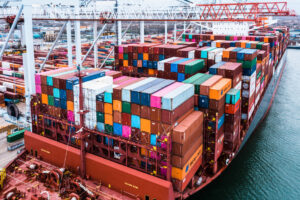
Panama Canal delays causing unrest for Shippers
The Panama Canal is currently facing disruptions due to low water levels and restrictions imposed to conserve water. Delays at the canal have already reached up to 15 days and are expected to increase further, impacting the flow of maritime trade. The situation arises from a dry spring and the looming El Niño weather pattern, affecting the water levels at the nearby Gatun Lake. These constraints are leading to shipping delays and diversions, particularly affecting trade between northeastern Asia and the U.S. West Coast, as the Panama Canal facilitates 46% of container movement between these regions.
Shippers are proactively looking for alternative routes to mitigate the delays and ensure their cargo reaches its destination. Longer intermodal routes and alternative shipping lanes, such as the Suez Canal, are being considered to avoid the Panama Canal disruptions. This is not the first time the global supply chain has faced maritime disruptions, with incidents like the Suez Canal blockage in 2021 prompting shippers to develop contingency plans. While rising Transpacific ocean rates have been driven by peak season volumes, canal-related issues have led to a spike in spot freight rates, affecting shipping costs.
Shippers opting for alternative routes should be prepared for longer lead times and potentially higher costs. Ocean carriers have not widely implemented additional fees due to the canal disruptions, but shippers are urged to stay abreast of the situation and adapt their supply chain strategies accordingly.
Interested? Click here to read more
Gartner suggests Robotics is the future of the Supply Chain
A recent Gartner study forecasts a significant shift in the adoption of automation technology within supply chains, favoring smart robots over drones. This is attributed to the maturity and established nature of mobile robot technology compared to drones. It’s projected that approximately 75% of companies are planning to integrate some form of robotic warehouse automation by 2027, according to Dwight Klappich, VP of Gartner’s Supply Chain Practice.
Labor shortages and the difficulties in retaining skilled talent, coupled with advancements in technologies like machine learning and artificial intelligence, are cited as driving forces behind this trend. The study underscores that mobile robots and drones will experience heightened demand due to the growing prominence of machine learning, which is expected to become “mainstream” in the next five years.
The report also emphasizes the role of standardized automation software, particularly in multi-agent orchestration platforms, in driving robotics adoption. As a result, Gartner foresees a rise in the number of mobile robots in supply chains over the next three years, and by 2027, more than three-quarters of companies are anticipated to have incorporated cyber-physical automation into their warehouse operations.
Read more here
Nvidia sees sales more than double
Nvidia, a technology giant, has reported record-breaking sales exceeding $13.5 billion in the last quarter, more than doubling its revenue, driven by soaring demand for its artificial intelligence (AI) chips. The company anticipates further sales growth in the current quarter and plans to repurchase $25 billion of its stock. Nvidia’s shares rose by over 6.5% in extended trading, continuing its remarkable gains this year. The firm’s data center business, particularly AI chips, was a major driver, with revenue surpassing $10.3 billion, a remarkable 170% increase from the previous year.
This surge in demand for Nvidia’s AI technology has positioned it as a major player in the AI market, with 95% of the machine learning market attributed to its technology. This rise in Nvidia’s revenue underscores the profound impact of AI technology on various sectors, particularly data centers and cloud computing. As AI becomes more integrated into businesses, its influence on supply chains will be significant.
It will reshape decision-making, optimize operations, and enhance efficiency, impacting inventory management, demand forecasting, and even distribution strategies. The robust demand for Nvidia’s AI chips reflects the broader trend of industries adopting AI to gain a competitive edge, and this surge in AI adoption will likely lead to a profound transformation of supply chain management strategies in the coming years.
Click here to read more
- SEO Powered Content & PR Distribution. Get Amplified Today.
- PlatoData.Network Vertical Generative Ai. Empower Yourself. Access Here.
- PlatoAiStream. Web3 Intelligence. Knowledge Amplified. Access Here.
- PlatoESG. Automotive / EVs, Carbon, CleanTech, Energy, Environment, Solar, Waste Management. Access Here.
- PlatoHealth. Biotech and Clinical Trials Intelligence. Access Here.
- ChartPrime. Elevate your Trading Game with ChartPrime. Access Here.
- BlockOffsets. Modernizing Environmental Offset Ownership. Access Here.
- Source: https://www.allthingssupplychain.com/supply-chain-weekly-wrap-up-08-18-2023-08-24-2023/?utm_source=rss&utm_medium=rss&utm_campaign=supply-chain-weekly-wrap-up-08-18-2023-08-24-2023
- :has
- :is
- :not
- $UP
- 15%
- 2021
- 95%
- a
- According
- accordingly
- adapt
- Additional
- Adopting
- Adoption
- advancements
- affecting
- AI
- AI adoption
- already
- also
- alternative
- and
- Anticipated
- anticipates
- approximately
- ARE
- artificial
- artificial intelligence
- Artificial intelligence (AI)
- AS
- asia
- At
- Automation
- avoid
- bbc
- BE
- become
- becomes
- been
- behind
- being
- between
- Billion
- broader
- business
- businesses
- but
- by
- Cargo
- causing
- Center
- Centers
- chain
- chains
- Chips
- cited
- click
- Cloud
- cloud computing
- Coast
- coming
- Companies
- company
- compared
- competitive
- computing
- considered
- constraints
- Container
- continuing
- Costs
- coupled
- Current
- Currently
- data
- Data Center
- data centers
- Days
- Decision Making
- delays
- Demand
- Demand forecasting
- destination
- develop
- difficulties
- disruptions
- distribution
- doubling
- driven
- driver
- driving
- Drones
- dry
- due
- Edge
- efficiency
- el
- emphasizes
- enhance
- ensure
- established
- Even
- expected
- experience
- faced
- facilitates
- facing
- Fees
- First
- first time
- five
- flow
- For
- Forces
- forecasts
- form
- freight
- from
- further
- future
- Gain
- Gains
- Gartner
- giant
- Global
- Growing
- Growth
- Have
- heightened
- higher
- HTTPS
- Impact
- impacting
- implemented
- imposed
- in
- Incorporated
- Increase
- industries
- influence
- integrate
- integrated
- Intelligence
- into
- inventory
- Inventory Management
- issues
- IT
- ITS
- jpg
- lake
- Last
- lead
- leading
- learning
- Led
- levels
- like
- likely
- longer
- looking
- looming
- Low
- machine
- machine learning
- major
- management
- Maritime
- Market
- maturity
- Mitigate
- Mobile
- more
- movement
- Nature
- next
- number
- ocean
- of
- on
- Operations
- Optimize
- orchestration
- over
- Panama
- particularly
- Pattern
- Peak
- planning
- plans
- Platforms
- plato
- Plato Data Intelligence
- PlatoData
- player
- positioned
- potentially
- practice
- prepared
- previous
- profound
- projected
- prominence
- Quarter
- Rates
- reached
- Reaches
- Read
- recent
- reflects
- regions
- remarkable
- report
- Reported
- reshape
- restrictions
- result
- retaining
- revenue
- Rise
- rising
- robot
- robotics
- robots
- robust
- Role
- ROSE
- routes
- s
- sales
- Season
- Sectors
- sees
- Shares
- shift
- Shipping
- shortages
- should
- significant
- situation
- skilled
- smart
- soaring
- Software
- some
- spike
- Spot
- spring
- stay
- stock
- strategies
- Study
- such
- Suggests
- supply
- supply chain
- supply chain management
- Supply chains
- surge
- Talent
- Technologies
- Technology
- than
- that
- The
- The Future
- their
- These
- this
- this year
- three
- time
- times
- to
- trade
- Trading
- Transformation
- Trend
- u.s.
- underscores
- unrest
- various
- volumes
- vp
- Warehouse
- Warehouse Automation
- Warehouse Operations
- was
- Water
- Weather
- weekly
- West
- which
- while
- widely
- will
- with
- within
- year
- years
- zephyrnet











